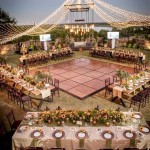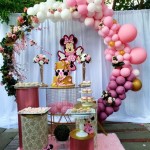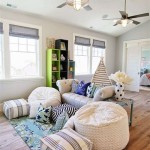Simple Ways To Decorate Your Living Room
The living room serves as a central hub for many households. It is a space for relaxation, entertainment, and socializing. A well-decorated living room can significantly enhance the overall ambiance of a home, creating a welcoming and comfortable environment for residents and guests alike. Decorating a living room does not necessarily require extensive renovations or a significant budget. There are numerous simple yet effective ways to transform the space and elevate its aesthetic appeal. This article explores several accessible strategies for decorating a living room, focusing on practical tips and readily available resources.
Strategic Furniture Arrangement
The arrangement of furniture plays a crucial role in the functionality and visual appeal of a living room. A thoughtfully designed layout can optimize space, improve traffic flow, and create a sense of balance and harmony. When arranging furniture, consider the focal point of the room, which could be a fireplace, a large window, or a television. Position the main seating area to face the focal point, creating a natural gathering space. Avoid overcrowding the room with too much furniture, as this can make the space feel cramped and cluttered. Instead, prioritize essential pieces and select furniture that is appropriately scaled for the size of the room.
A common mistake is pushing all the furniture against the walls in an attempt to maximize floor space. While this might seem logical, it can actually make the room feel smaller and less inviting. Instead, try floating some of the furniture away from the walls to create a more intimate and conversational arrangement. For example, positioning a sofa a few inches away from the wall can create a sense of depth and visual interest. Similarly, arranging armchairs around a coffee table in the center of the room can foster a more engaging and interactive atmosphere.
Pay attention to the flow of traffic through the room. Ensure that there are clear pathways for people to move around without having to navigate obstacles or squeeze through tight spaces. Ideally, there should be at least three feet of space between furniture pieces and walkways. When arranging furniture, consider the placement of doors, windows, and electrical outlets. Avoid blocking access to these essential features with furniture. Also, ensure that there are adequate outlets available for lamps, electronics, and other devices.
Consider incorporating a variety of seating options to accommodate different needs and preferences. A combination of sofas, armchairs, and ottomans can provide comfortable seating for individuals and groups. Choose furniture pieces that are both stylish and functional, and that reflect the overall aesthetic of the room. A sectional sofa can provide ample seating for large families or frequent entertainers, while a cozy armchair can create a comfortable reading nook. An ottoman can serve as both a footrest and an extra seat, adding versatility to the space.
Rugs can define distinct zones within the living room, particularly in open-concept spaces. An area rug placed beneath a seating arrangement can anchor the furniture and create a cohesive gathering space. Choose a rug that is appropriately sized for the area it is meant to define. The front legs of the sofa and armchairs should ideally be on the rug, creating a sense of connection between the furniture pieces. The rug's pattern, color, and texture can also contribute to the room's overall aesthetic, adding visual interest and warmth.
Lighting is another crucial element to consider when arranging furniture. Incorporate a variety of lighting sources, including ambient lighting, task lighting, and accent lighting. Ambient lighting provides overall illumination, while task lighting provides focused light for specific activities such as reading or working. Accent lighting highlights particular features or objects in the room, such as artwork or architectural details. Place lamps strategically throughout the room to create a warm and inviting atmosphere. A floor lamp beside a sofa or armchair can provide task lighting for reading, while a table lamp on a side table can add ambient light to the room.
Incorporating Color and Texture
Color and texture are powerful tools for transforming the look and feel of a living room. A carefully selected color palette can create a specific mood or atmosphere, while texture can add depth, dimension, and visual interest. When choosing colors for a living room, consider the size of the room, the amount of natural light, and the desired mood. Lighter colors tend to make a room feel larger and brighter, while darker colors can create a more intimate and cozy atmosphere. Consider using a neutral color palette for the walls and then adding pops of color through accessories, such as pillows, throws, and artwork.
In addition to the walls, consider the color of the furniture, flooring, and other elements in the room. These elements should complement each other to create a cohesive and harmonious look. You can use the color wheel as a guide for choosing colors that work well together. Complementary colors, such as blue and orange, create a vibrant and dynamic contrast. Analogous colors, such as blue, green, and purple, create a more harmonious and calming effect. Monochromatic color schemes, which use different shades and tints of a single color, can create a sophisticated and elegant look.
Texture can be introduced through a variety of materials, such as fabrics, wood, metal, and glass. Incorporating a mix of textures can add depth and visual interest to the room. For example, a plush velvet sofa can be paired with a woven rug and a smooth glass coffee table. Different textures catch the light in different ways, creating a dynamic and engaging visual experience. Consider using textured pillows and throws to add warmth and comfort to the seating area. A woven basket can provide storage while also adding texture to the room. A textured wall treatment, such as wallpaper or board and batten, can add architectural interest and visual depth.
Artwork can also add color and texture to a living room. Choose artwork that reflects your personal style and that complements the overall aesthetic of the room. Consider the size and scale of the artwork, as well as the colors and textures. A large statement piece can serve as a focal point for the room, while smaller pieces can be arranged in a gallery wall. Incorporate a variety of art mediums, such as paintings, prints, photographs, and sculptures, to add visual interest and depth. Consider the frame or mounting of the artwork, as this can also contribute to the overall aesthetic. A simple, minimalist frame can allow the artwork to take center stage, while a more ornate frame can add a touch of elegance and sophistication.
Plants are a natural and effective way to add color, texture, and life to a living room. Plants can also improve air quality and create a more calming and relaxing atmosphere. Choose plants that are appropriate for the light conditions in the room. Some plants thrive in bright, indirect light, while others can tolerate low light conditions. Consider the size and shape of the plants, as well as their foliage and flowers. A large, leafy plant can serve as a focal point for the room, while smaller plants can be arranged on shelves or side tables. Grouping plants together can create a more dramatic and visually appealing effect. Use decorative pots and planters to add color and texture to the plant display.
Accessorizing and Personalizing the Space
Accessories are the finishing touches that can tie a living room together and reflect the personal style of the occupants. Choosing the right accessories can elevate the overall aesthetic of the room, making it feel more inviting and personalized. Accessories can include items such as pillows, throws, curtains, lamps, mirrors, artwork, and decorative objects. When choosing accessories, consider the color, texture, and scale of the items, as well as their overall style and function. Avoid cluttering the room with too many accessories, as this can make the space feel disorganized and overwhelming. Instead, focus on selecting a few key pieces that will make a statement and add personality to the room.
Pillows and throws are a simple and effective way to add color, texture, and comfort to the seating area. Choose pillows and throws that complement the color palette of the room and that are made from soft, comfortable materials. Layer different sizes and shapes of pillows to create a more visually appealing and inviting arrangement. A patterned throw can add a pop of color and texture to a neutral sofa, while a solid-colored throw can provide warmth and comfort on a chilly evening. Experiment with different fabric textures, such as velvet, linen, and wool, to add depth and dimension to the seating area.
Curtains can add privacy, filter light, and enhance the overall aesthetic of the living room. Choose curtains that are appropriate for the size and style of the room, and that complement the color palette. Consider the weight and texture of the fabric, as well as the length and width of the curtains. Light, airy curtains can create a bright and airy atmosphere, while heavier curtains can provide more privacy and block out light. Hang the curtains high and wide to make the windows appear larger and to maximize natural light. Consider adding decorative hardware, such as curtain rods and tiebacks, to add a touch of elegance and sophistication.
Mirrors can be used to create the illusion of space and to reflect light, making a room feel larger and brighter. Hang a large mirror on a wall to create a focal point or to reflect a view from a window. Arrange smaller mirrors in a gallery wall to add visual interest and depth. Consider the shape and style of the mirror, as well as the frame or mounting. A decorative mirror can add a touch of elegance and sophistication to the room, while a simple, minimalist mirror can blend seamlessly with the decor.
Personalize the space with items that reflect your interests and hobbies. Display books, photographs, and souvenirs to create a more inviting and personalized atmosphere. Arrange these items on shelves, side tables, and coffee tables. Consider using decorative boxes and baskets to organize and conceal clutter. Frame personal photographs and artwork to add a personal touch to the room. A bookshelf filled with favorite books can add a sense of warmth and character to the space.
Lighting fixtures are functional items that can also serve as decorative accents. Choose lighting fixtures that complement the overall style of the room and that provide adequate illumination. Incorporate a variety of lighting sources, including ambient lighting, task lighting, and accent lighting. A stylish chandelier can add a touch of elegance and sophistication to the room, while a modern floor lamp can provide task lighting for reading. Use dimmer switches to control the intensity of the light and to create a more ambient atmosphere. Consider the finish and material of the lighting fixtures, as well as the shape and style of the shades.
:strip_icc()/cdn.cliqueinc.com__cache__posts__261309__simple-living-room-ideas-261309-1529706398941-image.700x0c-a06c8bf26ad94d6294cf1c2ff7356b2e-b46a1cbe8c2b486497ab37e7bd098606.jpg?strip=all)
40 Best Simple Living Room Design And Decor Ideas
:max_bytes(150000):strip_icc()/Mercedes-White-Small-Living-Room-58a8c6dc3df78c345b35e545.jpg?strip=all)
15 Simple Small Living Room Ideas For Minimalist Style
:strip_icc()/cdn.cliqueinc.com__cache__posts__261309__simple-living-room-ideas-261309-1529706401614-image.700x0c-cbcfa36653544bd2ad58661043f6e6d0-b5cc4c78b0c24a1f9a15cb1ea95f8b92.jpg?strip=all)
40 Best Simple Living Room Design And Decor Ideas
:strip_icc()/cdn.cliqueinc.com__cache__posts__261309__simple-living-room-ideas-261309-1529706400046-image.700x0c-b792da9843d54a61b44e6314a147040f-0bd39ee8cfd7414d84058618222e2a35.jpg?strip=all)
40 Best Simple Living Room Design And Decor Ideas

Simple Guide For Decorating Your Living Room Beautiful Homes
:strip_icc()/cdn.cliqueinc.com__cache__posts__261309__simple-living-room-ideas-261309-1529706400396-image.700x0c-0157c44cd01a42078aa7e5af7482989a-b0c953a4854f408f9a286dc52a134611.jpg?strip=all)
40 Best Simple Living Room Design And Decor Ideas
:strip_icc()/cdn.cliqueinc.com__cache__posts__261309__simple-living-room-ideas-261309-1529706401065-image.700x0c-f8fc925d7a234f5eb33e565e898e6857-723d857fef8542df92f287cb32d4d9f4.jpg?strip=all)
40 Best Simple Living Room Design And Decor Ideas

30 Easy And Unexpected Living Room Decorating Ideas Colourful Simple Decoration

Simple Living Room Design Ideas For Your Home Designcafe

Simple Living Room Ideas For Perfectly Understated Style Decorilla Interior Design
Related Posts







